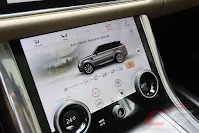Let’s get one thing out of the way first: the Range Rover Sport isn’t Land Rover’s flagship SUV. Despite sharing its name as well as a bulging list of standard specs, the Range Rover Sport actually sits below the brand’s real flagship—the simply-named Range Rover. Think XF to the XJ in Jaguar-speak, or the X5 to the X7 in BMW lingo. The confusing naming convention aside, there’s nothing confusing about the Range Rover Sport—this here is one desirable luxury SUV, undeniably comfortable and refined in every aspect.
Sharing the same aluminum construction as the full-fat Range Rover, the Sport is positioned as their most dynamic model; but don’t expect it wrap and shrink around you like a sportscar. Land Rover says the Sport is 400 kilograms lighter
than its predecessor, but tipping the scales at 2,539 kilograms, it’s no lightweight. Nonetheless, it’s an enjoyable drive thanks to its trick air suspension and sophisticated four-wheel drive system. And while this entire drive is
limited to surfaces made of cement and asphalt, Land Rover’s off-road credentials are very much alive here with up to 278 mm of ground clearance and water wading depth of up to 850 mm.
Without a doubt, the star of the Range Rover Sport is this: the new P400e plug-in hybrid. It’s befitting of the brand for nothing screams luxury like the sound of silence. With the battery topped up, Land Rover claims it’ll run without
a drop of unleaded for up to 50 kilometers. The real-world figures don’t really match up (the display read a maximum range of just 28 kilometers), but every meter of it is pure motoring bliss. Once the battery’s depleted though, it’s
impossible to charge on the go, even using regenerative braking. Still, even as the engine fired up, the resulting figure rested at 8.62 km/L. It’s a far cry from the claimed 31.25 km/L, but it’s still not bad considering the Sport’s
hefty size and weight.
When not being gingerly on the accelerator, the Sport PHEV returns a healthy blast of acceleration. The century mark arrives in 6.3 seconds, but it feels faster than that. The 2.0-liter engine together with the electric motor delivers a
combined 404 horsepower and 640 Nm of torque, enough to dig you into the driver’s seat. It’s fun and somewhat scary at the same time. Driven more sensibly though, you can sense a bit of hesitation at lower speeds, especially when
puttering around town. Ask for a sudden burst of acceleration, and it’ll pause before ungracefully hurling you forward.
Close to two meters in width, the Range Rover Sport isn’t a small car by any measure. However, it manages to remain true to its name because it’s effortless to drive. It belittles its size thanks to its stability and agility. Most
important of all, it’s consistent, whether being pushed in a straight line or flogged along a twisty road. Adjustable air suspension is standard, and while it comes with various modes, you don’t have to fiddle with any of them to get a
smooth, comfortable experience. Oh, and despite being fitted with 21-inch wheels, it’s extremely supple, absorbing all road surface imperfections.
From the driver’s seat, the Range Rover Sport makes you feel its size. Even at the seat’s lowest setting, there’s a considerable height advantage compared with most other traffic. With 16 ways of power adjustable for both the driver and
front passenger, the seats are lounge-like in their comfort, and even come with their own armrests too. Plus, there’s generous space even for long-legged people upfront, while those at the back will be treated to equally good space.
Taking center stage inside is Land Rover’s new InControl Touch Pro which basically adds dual touchscreen display screens stacked on top of each other. There are two 12.3-inch screens where you’d expect them (one in front of the driver,
and another at the center of the dash), but there’s another giant one just ahead of the shifter. This giant pane of glass incorporates the climate control, phone, and drive settings. Navigating through the screens is easy enough, while
the quality and clarity of the screens provide yet another added premium touch to the cabin. However, it’ll never be as user-friendly as having tactile buttons and switches. Oh, and not having standard Apple CarPlay and Android Auto is
a mortal sin here.
The lack of smartphone connectivity aside, the rest of the cabin can’t be faulted. It’s every inch impressive, dressed in high-quality materials. Moreover, it comes with a laundry list of top-notch equipment including adaptive LED
headlights, a 360-degree camera with front and rear sensors, power tailgate, offline GPS navigation, panoramic sunroof, four-zone climate control, and the 19-speaker Meridian Surround Sound system.
In the end, no one should dive into the Range Rover Sport PHEV with their heart set on saving the earth. On paper, the electric range and fuel economy are impressive, but these test lab figures are far from what you’d expect in the real
world. What’s undeniable though is that with its P 9.490 million price tag, this version of the Range Rover Sport is actually more affordable than even the diesel by about P 500,000. It’s great value. Plus, this monetary saving is
enough to cover the cost of a wall charger (P 105,000). That means, for as long as you keep your trips short, you will never need to spend on a single drop of fuel. Range and fuel economy issues aside, the Ranger Rover PHEV is a
versatile luxury SUV that’s not just lovely to look at, but lovely to drive as well.





























No comments:
Post a Comment
Feel free to comment or share your views. Comments that are derogatory and/or spam will not be tolerated. We reserve the right to moderate and/or remove comments.